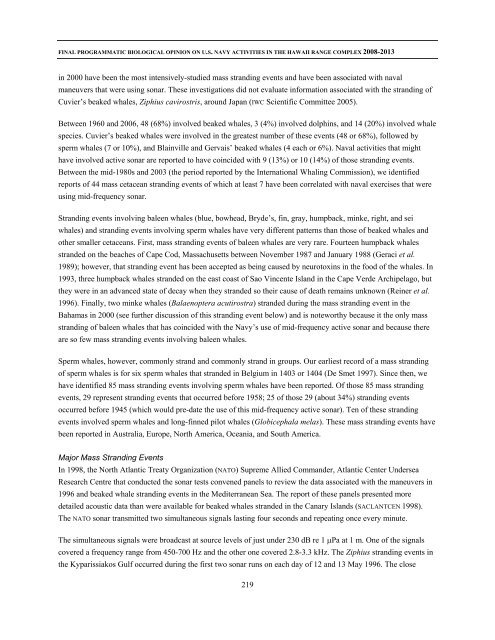NMFS Biological Opinion on U.S. Navy training ... - Govsupport.us
NMFS Biological Opinion on U.S. Navy training ... - Govsupport.us
NMFS Biological Opinion on U.S. Navy training ... - Govsupport.us
Create successful ePaper yourself
Turn your PDF publications into a flip-book with our unique Google optimized e-Paper software.
FINAL PROGRAMMATIC BIOLOGICAL OPINION ON U.S. NAVY ACTIVITIES IN THE HAWAII RANGE COMPLEX 2008-2013<br />
in 2000 have been the most intensively-studied mass stranding events and have been associated with naval<br />
maneuvers that were <strong>us</strong>ing s<strong>on</strong>ar. These investigati<strong>on</strong>s did not evaluate informati<strong>on</strong> associated with the stranding of<br />
Cuvier’s beaked whales, Ziphi<strong>us</strong> cavirostris, around Japan (IWC Scientific Committee 2005).<br />
Between 1960 and 2006, 48 (68%) involved beaked whales, 3 (4%) involved dolphins, and 14 (20%) involved whale<br />
species. Cuvier’s beaked whales were involved in the greatest number of these events (48 or 68%), followed by<br />
sperm whales (7 or 10%), and Blainville and Gervais’ beaked whales (4 each or 6%). Naval activities that might<br />
have involved active s<strong>on</strong>ar are reported to have coincided with 9 (13%) or 10 (14%) of those stranding events.<br />
Between the mid-1980s and 2003 (the period reported by the Internati<strong>on</strong>al Whaling Commissi<strong>on</strong>), we identified<br />
reports of 44 mass cetacean stranding events of which at least 7 have been correlated with naval exercises that were<br />
<strong>us</strong>ing mid-frequency s<strong>on</strong>ar.<br />
Stranding events involving baleen whales (blue, bowhead, Bryde’s, fin, gray, humpback, minke, right, and sei<br />
whales) and stranding events involving sperm whales have very different patterns than those of beaked whales and<br />
other smaller cetaceans. First, mass stranding events of baleen whales are very rare. Fourteen humpback whales<br />
stranded <strong>on</strong> the beaches of Cape Cod, Massach<strong>us</strong>etts between November 1987 and January 1988 (Geraci et al.<br />
1989); however, that stranding event has been accepted as being ca<strong>us</strong>ed by neurotoxins in the food of the whales. In<br />
1993, three humpback whales stranded <strong>on</strong> the east coast of Sao Vincente Island in the Cape Verde Archipelago, but<br />
they were in an advanced state of decay when they stranded so their ca<strong>us</strong>e of death remains unknown (Reiner et al.<br />
1996). Finally, two minke whales (Balaenoptera acutirostra) stranded during the mass stranding event in the<br />
Bahamas in 2000 (see further disc<strong>us</strong>si<strong>on</strong> of this stranding event below) and is noteworthy beca<strong>us</strong>e it the <strong>on</strong>ly mass<br />
stranding of baleen whales that has coincided with the <strong>Navy</strong>’s <strong>us</strong>e of mid-frequency active s<strong>on</strong>ar and beca<strong>us</strong>e there<br />
are so few mass stranding events involving baleen whales.<br />
Sperm whales, however, comm<strong>on</strong>ly strand and comm<strong>on</strong>ly strand in groups. Our earliest record of a mass stranding<br />
of sperm whales is for six sperm whales that stranded in Belgium in 1403 or 1404 (De Smet 1997). Since then, we<br />
have identified 85 mass stranding events involving sperm whales have been reported. Of those 85 mass stranding<br />
events, 29 represent stranding events that occurred before 1958; 25 of those 29 (about 34%) stranding events<br />
occurred before 1945 (which would pre-date the <strong>us</strong>e of this mid-frequency active s<strong>on</strong>ar). Ten of these stranding<br />
events involved sperm whales and l<strong>on</strong>g-finned pilot whales (Globicephala melas). These mass stranding events have<br />
been reported in A<strong>us</strong>tralia, Europe, North America, Oceania, and South America.<br />
Major Mass Stranding Events<br />
In 1998, the North Atlantic Treaty Organizati<strong>on</strong> (NATO) Supreme Allied Commander, Atlantic Center Undersea<br />
Research Centre that c<strong>on</strong>ducted the s<strong>on</strong>ar tests c<strong>on</strong>vened panels to review the data associated with the maneuvers in<br />
1996 and beaked whale stranding events in the Mediterranean Sea. The report of these panels presented more<br />
detailed aco<strong>us</strong>tic data than were available for beaked whales stranded in the Canary Islands (SACLANTCEN 1998).<br />
The NATO s<strong>on</strong>ar transmitted two simultaneo<strong>us</strong> signals lasting four sec<strong>on</strong>ds and repeating <strong>on</strong>ce every minute.<br />
The simultaneo<strong>us</strong> signals were broadcast at source levels of j<strong>us</strong>t under 230 dB re 1 μPa at 1 m. One of the signals<br />
covered a frequency range from 450-700 Hz and the other <strong>on</strong>e covered 2.8-3.3 kHz. The Ziphi<strong>us</strong> stranding events in<br />
the Kyparissiakos Gulf occurred during the first two s<strong>on</strong>ar runs <strong>on</strong> each day of 12 and 13 May 1996. The close<br />
219








